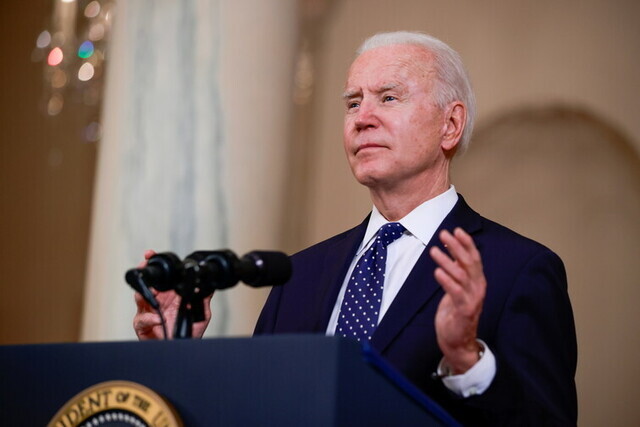hankyoreh
Links to other country sites 다른 나라 사이트 링크
US may join CPTPP sooner than expected, expert says

The US may move to hasten its membership in the Comprehensive and Progressive Agreement for Trans-Pacific Partnership (CPTPP) if its conflict with China continues, a US expert has predicted.
The prediction is drawing notice for being at odds with the majority expectation that the Joe Biden administration will not move to join the CPTPP until the mid-term elections in 2022.
Appearing as a presenter at a Trade Forum co-organized by the Korea Chamber of Commerce and Industry (KCCI) and the law firm Kim & Chang at the KCCI building in Seoul on Wednesday, Peterson Institute for International Economics senior fellow Jeffrey Schott said the economic and security challenges posed by China may leave the US feeling a need to strengthen its relationships with key allies.
Schott went on to predict that renewed CPTPP negotiations and “rebranding” of agreements in the Asia-Pacific region may take place as part of the US response.
He predicted that since agreements in the Asia-Pacific region, including the CPTPP, the Regional Comprehensive Economic Partnership (RCEP) and bilateral free trade agreements (FTAs) work against US competitiveness, US participation in an amended CPTPP would form a more equitable competition environment for US trade and investment.
Not only has the Biden administration not rejected the CPTPP agreement, but it senses a need to improve it and make it into a stronger agreement, he said.
The CPTPP went into effect in December 2018 with 11 member countries, including Japan, Australia, Canada and Mexico.
The partnership’s roots lie in the Trans-Pacific Partnership (TPP). After the US bowed out of the TPP in late 2017, Japan assumed the lead, and the name was changed to its current “CPTPP.” South Korea still has yet to join.
The RCEP was launched in November 2020 with a total of 15 members, including South Korea, China, Japan, Australia and New Zealand, along with the ten members of the Association of Southeast Asian Nations (ASEAN).
Commenting on South Korea, Schott said it would be in its interests to join the CPTPP quickly, adding that this would allow it to gain the upper hand when concluding a trilateral FTA with China and Japan.
He also said South Korea has no cause for hesitation over joining the CPTPP, as the agreement’s terms are similar to the South Korea-US FTA, and South Korea already has FTAs with most member countries.
Shin Jung-hoon, an attorney with Kim & Chang, explained that the procedures for the CPTPP did not involve drafting agreements but accepting the agreement text already agreed upon by the existing members.
For this reason, he stressed the importance of having a clear understanding of the meaning of the agreement text. In particular, he called for a careful examination of the impact that its state-owned enterprise chapter would have on the operation of public institutions.
Kim Ba-woo, a Korea Institute for Industrial Economics & Trade researcher who spoke on the area of manufacturing, also said the costs and benefits of the CPTPP should be carefully weighed, as it was expected to include faster and higher levels of market openness than the RCEP.
Kim also said there would need to be analysis and examination of the marking opening effects in terms of Japan if South Korea decides to participate.
KCCI Vice President Woo Tae-hee, who presided over the meeting, said that the CPTPP demands the highest level of liberalization scope and norms among trade agreements.
On that basis, he stressed the importance of careful examination and prior response steps.
By Kim Young-bae, senior staff writer
Please direct comments or questions to [english@hani.co.kr]

Editorial・opinion
![[Column] Season 2 of special prosecutor probe may be coming to Korea soon [Column] Season 2 of special prosecutor probe may be coming to Korea soon](https://flexible.img.hani.co.kr/flexible/normal/500/300/imgdb/original/2024/0426/3317141030699447.jpg) [Column] Season 2 of special prosecutor probe may be coming to Korea soon
[Column] Season 2 of special prosecutor probe may be coming to Korea soon![[Column] Park Geun-hye déjà vu in Yoon Suk-yeol [Column] Park Geun-hye déjà vu in Yoon Suk-yeol](https://flexible.img.hani.co.kr/flexible/normal/500/300/imgdb/original/2024/0424/651713945113788.jpg) [Column] Park Geun-hye déjà vu in Yoon Suk-yeol
[Column] Park Geun-hye déjà vu in Yoon Suk-yeol- [Editorial] New weight of N. Korea’s nuclear threats makes dialogue all the more urgent
- [Guest essay] The real reason Korea’s new right wants to dub Rhee a founding father
- [Column] ‘Choson’: Is it time we start referring to N. Korea in its own terms?
- [Editorial] Japan’s rewriting of history with Korea has gone too far
- [Column] The president’s questionable capacity for dialogue
- [Column] Are chaebol firms just pizza pies for families to divvy up as they please?
- [Column] Has Korea, too, crossed the Rubicon on China?
- [Correspondent’s column] In Japan’s alliance with US, echoes of its past alliances with UK
Most viewed articles
- 1[Column] Season 2 of special prosecutor probe may be coming to Korea soon
- 2‘We must say no’: Seoul defense chief on Korean, USFK involvement in hypothetical Taiwan crisis
- 3Is N. Korea threatening to test nukes in response to possible new US-led sanctions body?
- 4Division commander ordered troops to enter raging flood waters before Marine died, survivor says
- 5Is Japan about to snatch control of Line messenger from Korea’s Naver?
- 6No good, very bad game for Korea puts it out of Olympics for first time since 1988
- 7[Editorial] Korea’s surprise Q1 growth requires objective assessment, not blind fanfare
- 8Korea’s 1.3% growth in Q1 signals ‘textbook’ return to growth, says government
- 9N. Korean delegation’s trip to Iran shows how Pyongyang is leveraging ties with Moscow
- 10Amnesty notes ‘erosion’ of freedom of expression in Korea in annual human rights report